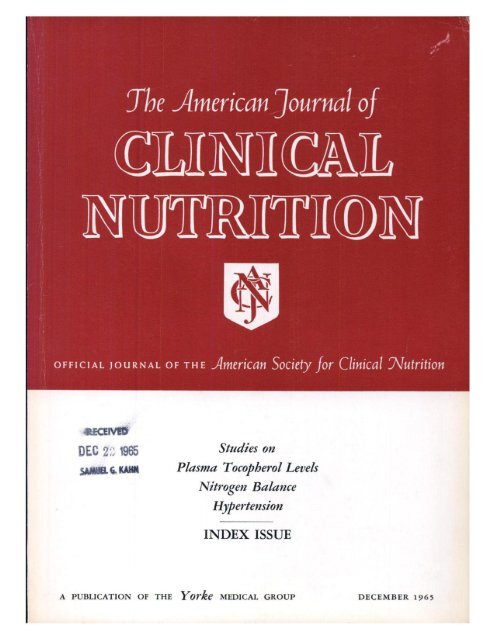膳食摄入多不饱和脂肪酸及其食物来源与女性和男性的生育能力:一项基于人群的孕前前瞻性队列研究
IF 6.5
1区 医学
Q1 NUTRITION & DIETETICS
引用次数: 0
摘要
背景:海鲜、坚果和种子是多不饱和脂肪酸(PUFAs)的主要膳食来源,它可能有益于生殖健康。目的:本研究旨在探讨孕周饮食摄入富含pufa的食物和omega-3和omega-6 pufa与女性和男性生育能力和低生育能力的关系。方法:在830名女性和651名男性中,从孕前开始参与了一项基于人群的前瞻性队列研究,我们通过问卷调查评估了中位妊娠12.4周(95%范围:10.9,18.4)的围孕期饮食摄入量和妊娠时间。可生育能力定义为1个月内怀孕的概率,而低生育能力定义为妊娠时间≥12个月或使用辅助生殖技术。Cox比例风险和逻辑回归用于评估PUFA(富含PUFA的食物)与生育能力和低生育能力之间的关系。结果:在女性中,富含pufa的食物摄入与生育能力没有显著相关性。较高的omega-3 PUFA摄入量,特别是二十二碳六烯酸和α -亚麻酸,而不是omega-6 PUFA,每标准差评分(SDS)增加与可育性增加和低生育能力降低相关。在最高四分位数的女性中观察到最强的影响。较低的omega-6与omega-3 PUFA比例与受精率增加和低生育风险相关[受精率(FR): 0.92, 95%可信区间(CI): 0.87, 0.96;比值比(OR): 1.14, 95% CI: 1.02, 1.26,每单位增加omega-6:omega-3 PUFA比例]。在雄性中,摄入较多的坚果/种子,而不是海鲜,与可育性增加和低生育能力降低相关(FR: 1.10, 95% CI: 1.01, 1.20;OR: 0.78, 95% CI: 0.63, 0.97 / SDS增加坚果/种子)。摄入最多的人受到的影响最大。在男性中没有观察到omega-3或omega-6 PUFA摄入量的关联。结论:在女性中,较高的膳食摄入omega-3 PUFAs可能有利于生育。增加坚果和种子的摄入量可以提高男性的生育能力,而不依赖于PUFA的摄入量。这些发现表明,有可能采取针对性别的饮食干预措施来支持生殖健康。本文章由计算机程序翻译,如有差异,请以英文原文为准。
Dietary intake of polyunsaturated fatty acids, their food sources and fertility in females and males: a preconception prospective population-based cohort study
Background
Seafood, nuts, and seeds are key dietary sources of polyunsaturated fatty acids (PUFAs), which may benefit reproductive health.
Objectives
This study aims to investigate associations of periconception dietary intake of PUFA-rich foods and omega-3 and omega-6 PUFAs with fecundability and subfertility in females and males.
Methods
Among 830 females and 651 males, participating in a population-based prospective cohort study from preconception onwards, we assessed periconception dietary intake at median 12.4-wk gestation (95% range: 10.9, 18.4) and time to pregnancy via questionnaires. Fecundability was defined as the probability of conceiving within 1 mo and subfertility as time to pregnancy ≥12 mo or use of assisted reproductive technology. Cox proportional hazards and logistic regression were used to assess associations between PUFA(-rich foods) with fecundability and subfertility.
Results
In females, PUFA-rich food intake was not significantly associated with fertility. Higher omega-3 PUFA intake, especially docosahexaenoic acid and alpha-linolenic acid, but not omega-6 PUFA, was per standard deviation score (SDS) increase associated with increased fecundability and reduced subfertility. Strongest effects were observed for females in the highest quartile. A lower omega-6 to omega-3 PUFA ratio was associated with increased fecundability and lower subfertility risk [fecundability ratio (FR): 0.92, 95% confidence interval (CI): 0.87, 0.96; odds ratio (OR): 1.14, 95% CI: 1.02, 1.26, per unit increase in omega-6:omega-3 PUFA ratio]. In males, higher intake of nuts/seeds, but not seafood, was associated with increased fecundability and lower subfertility (FR: 1.10, 95% CI: 1.01, 1.20; OR: 0.78, 95% CI: 0.63, 0.97 per SDS increase in nuts/seeds). Strongest effects were present for those who consumed the highest amount. No associations were observed for omega-3 or omega-6 PUFA intake in males.
Conclusions
In females, higher dietary omega-3 PUFAs intake may benefit fertility. Increased nuts and seeds consumption may improve fertility in males, independent of PUFA intake. These findings suggest potential for gender-specific dietary interventions to support reproductive health.
求助全文
通过发布文献求助,成功后即可免费获取论文全文。
去求助
来源期刊
CiteScore
12.40
自引率
4.20%
发文量
332
审稿时长
38 days
期刊介绍:
American Journal of Clinical Nutrition is recognized as the most highly rated peer-reviewed, primary research journal in nutrition and dietetics.It focuses on publishing the latest research on various topics in nutrition, including but not limited to obesity, vitamins and minerals, nutrition and disease, and energy metabolism.
Purpose:
The purpose of AJCN is to:
Publish original research studies relevant to human and clinical nutrition.
Consider well-controlled clinical studies describing scientific mechanisms, efficacy, and safety of dietary interventions in the context of disease prevention or health benefits.
Encourage public health and epidemiologic studies relevant to human nutrition.
Promote innovative investigations of nutritional questions employing epigenetic, genomic, proteomic, and metabolomic approaches.
Include solicited editorials, book reviews, solicited or unsolicited review articles, invited controversy position papers, and letters to the Editor related to prior AJCN articles.
Peer Review Process:
All submitted material with scientific content undergoes peer review by the Editors or their designees before acceptance for publication.

 求助内容:
求助内容: 应助结果提醒方式:
应助结果提醒方式:


